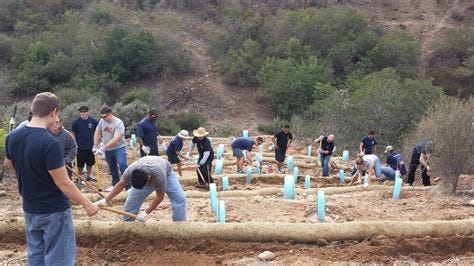Doing good: San Diego Canyonlands
Neighborhood groups conserve and restore nature in urban canyons
Along a busy city street, a path drops down into shrubs and bushes. Just steps past the concrete and traffic a scrub jay floats by, and a thrasher, distinguished by his curved beak, struts among the coastal sage. Cars and houses give way to trees, shrubs, and flowers.
These are the wonders that can be found in San Diego’s urban canyons, refuges of nature that interlace this southern California city. If you view the city from above using Google Earth, the canyons seem to branch out this way and that, as though some concrete-consuming organism ate away at the city’s roads and houses.

All told, there are about 150 canyons in the San Diego urban area. Some are small, spanning half a city block and extending not much farther. Others are expansive, winding for miles through several neighborhoods. Other cities have their parks or waterfronts, but San Diego is unique in the way its canyons bring nature into the city’s neighborhoods. Most neighborhoods have at least one canyon as an open area free of streets and buildings.
Aiding the stewardship of these canyons is San Diego Canyonlands, a nonprofit that began as part of the local chapter of the Sierra Club. "Canyonlands works to preserve and restore the health of the remaining open spaces, urban fragments of nature. These natural areas are across the street from where people live,” says Clayton Tschudy, who has served as the nonprofit’s executive director since the end of 2019.
Originally a professional musician, Tschudy (pronounced SHOE-dee) soon transitioned to environmental nonprofits. "I volunteered extensively with different nonprofits from my 20's and on,” he says. He served as a board member of the San Diego chapter of the California Native Plant Society and worked with other volunteers to start a native plant garden tour.
The secret to Canyonlands’ success is that it focuses on neighborhood action. Care for the canyons and advocacy is done by canyon “friends” groups. Neighbors who live around a canyon will form a group to remove trash, mitigate erosion, and reinvigorate the area with native plants. Canyonlands, as an organization, helps these groups through funding and guidance as to what types of native plants to use in restoration projects.
More than just garden clubs or beautification committees, the canyon friends groups perform essential ecological work. Because San Diego County straddles coast, mountains, and desert, encompassing coastal estuaries, alpine woodlands, and the westernmost reaches of the Sonoran Desert, the County has more biodiversity than any other county in North America. And much of that biodiversity can be found within its urban canyons. The canyons that lie among the streets, shopping malls, and highways are home to 85 rare, threatened, and endangered species. Many of these species are only found in this small corner of southern California and northern Baja, Mexico.

On a typical canyon hike, it is not unusual to come in contact with at least one or two of these rare and endangered plants or animals. Distinguished by its azure blue flowers, the Lakeside ceanothus is only found in portions of southern California and northern Baja, Mexico. The coastal California gnatcatcher, a small perching bird, makes its home in the coastal sage scrub, which is now rarely found in San Diego County except in the urban canyons.
Natural history and human history give San Diego its natural canyons
San Diego County is a land of mesas, large swaths of flatland. These are largely sandstone and sandstone conglomerate laid down between 55 and 33.7 million years ago during the Eocene period. Ocean waves eroded and flattened these areas, creating what are called marine terraces.
In more recent times, starting in the last three million years, these marine terraces were then uplifted, giving us the mesas. Over millennia, erosion then carved out the canyons. During the 20th century, as human development spread through this area, particularly after WWII, developers built their streets, houses, and shopping malls on the flat mesas, leaving the canyons relatively untouched. Larger earthmoving equipment in recent decades and the push for new urban development led to some encroachment on the canyons, but in many cases, they remained undeveloped.
More encroachment
In 1998, the city of San Diego planned to build roads in many of the canyons to ease access for sewer maintenance. Folks who lived around Switzer Canyon, a large spur of land that extends from the city’s Balboa Park, informed city leaders that they appreciated the bit of nature the canyon brought them. A road running through it would impinge on their small slice of the natural world.
The city kept its tarmac out, but the threat to the peacefulness and beauty of Switzer Canyon prompted folks to realize that all of San Diego’s canyons needed regular vigilance. Folks also realized that their canyons needed some care. Many canyons were being misused as dumping grounds and degraded by exotic and invasive species. With the support of the local chapter of the Sierra Club, San Diego Canyonlands was born.
Although the coronavirus pandemic has taken its toll on businesses and organizations, Canyonlands has been able to thrive. “In the last year our organization has been transformed,” Tschudy says. Through grants, the nonprofit was able to increase staffing. They also began working with the San Diego Workforce Partnership, in which youth and other individuals who need to increase their work experience participate in canyon restoration and other Canyonlands activities.
With more urban sprawl and development, Tschudy anticipates further challenges for Canyonlands. “The remaining habitats in the urban edge will continue to degrade,” he says. “It's critically important that we restore optimal habitat conditions in those canyons to mitigate for continuing urban habitat loss in our region.”
For more environmental news that doesn’t make the headlines, follow me on Twitter @EcoScripsit




